Exercises (2269)
Tennis: coordination with racket and ball
Forms of play / exercises
Simple coordination exercises with racket and ball are suitable for tennis beginners:
Balance the ball on the racket (in motion).
Balance the ball at eye level on the racket (in motion).
Push the ball up from the bottom to the top with the forehand face of the racket.
Push the ball up from the bottom to the top with the backhand face of the racket.
Push the ball up from the bottom to the top alternately with the forehand and backhand faces of the racket. After each pass (forehand/backhand), optionally play the ball upwards once with your free hand.
Bounce the ball upwards with the forehand face of the racket (without the ball hitting the ground).
Bounce the ball upwards with the backhand face of the racket (without the ball hitting the ground).
Bounce the ball upwards alternately with the forehand and backhand faces of the racket (without the ball hitting the ground).
Bounce the ball upwards twice with the racket, let the ball hit the ground and bounce it upwards twice again.
Bounce the ball upwards with the racket, after a few touches try to play the ball upwards with the frame.
Bounce the ball downwards (in motion - always keep the racket above the ball).
With partner:
Player 1 plays the ball upwards, the next ball is played upwards by the partner.
Player 1 plays the ball upwards, the partner lets the ball hit the ground before playing the ball upwards.
Player 1 bounces the ball, the next ball is bounced by the partner.
2 players pass the ball to each other along a line, but the ball is first caught with the free hand before being returned. In the first phase, let the ball hit the ground and pass it back, then pass the ball directly from the air to your partner.
2 players pass the ball to each other along a line (forehand/backhand/alternating forehand and backhand).
Per participant:
1 tennis racket
1 tennis ball
Tennis: technique training
Forms of play / exercises
Exercises with a throw-off or lead-off by the leader are suitable for technical aspects of training.
Teaching the forehand and backhand technique:
Exercise 1: the player drops balls and the leader holds the player's racket, so the player has to take a high loop, swing under the leader's racket and hit the ball to the other side.
Exercise 2: as above, but the leader leaves the racket as an aid and drops the balls again.
Exercise 3: the leader passes balls to the player, who must perform the same stroke sequence from the movement to the ball.
Exercise 4: the leader plays from the opposite side with the racket and the player performs the same stroke sequence (further distance).
Per participant:
1 tennis racket
x tennis balls
Test form
Interval training
Individual work
The participants are independently responsible for the evaluation of their test!
Exercise duration: 2 minutes
Pause: 2 minutes and 30 seconds
Repeats: 4 times
Intensity level: 4 (hard)
Max HR: 90-95%
Rule of speech: brief exchange of words
In this type of test, it is important that the participants try to cover the same distance in the specified time for each interval.
The test form can be carried out as follows:
- Round track: To ensure that the participants have enough space available for the run, they can be spread out on the round track at the start. The load starts from the same starting point for each individual runner for each repetition. During the breaks, the participants return to their starting point. This allows participants to check/calculate the distance travelled after each interval. The sports director has all participants in view and can therefore start or stop the intervals with a signal.
- Distance of at least 700 metres: Distances are marked with signs (every 25-50 metres). Each participant receives a stop/pulse watch, runs the course independently and memorises the distance covered (it is possible to stagger the start of the participants). After the break time has elapsed, the participants run the distance they ran back to the starting point. During the breaks, the participants wait in place or continue running at a relaxed trot, but return to the starting point in good time (end of the previous interval). If the course allows, the sports director can give the start/stop signal for all participants (no staggering possible).
Variant: If you only have a short course available, you must turn around at the end of the course and continue running in the opposite direction until the end of the load time. At the next interval, the participants run the distance they ran earlier in the opposite direction back to the starting point. - Longer-distance circuit: The distances are marked with signs (every 25-50 metres). Each participant receives a stop/pulse watch, runs the course independently and calculates the distance travelled (no staggered start of the participants necessary). During the breaks, the participants wait in place or continue running at a relaxed trot until the end of the break time. For each interval, the participants must calculate the distance travelled based on the start/end point of the interval. After the last interval, all runners return to the starting point, which takes additional time.
After each interval, participants either have the option of writing down the distance covered (writing materials available on the track or on Mann) or memorising the four distances to write them down at the end of the test. The distances covered per interval are noted and totalled.
To evaluate the test, the distances covered for the four intervals are totalled. The result is noted down and can be compared with the next test. It is also worth dividing the result by the number of intervals (4) so that you have a comparative value for the individual intervals for the next test.
Distance markers (signs with metres)
1 signalling device (e.g. whistle)
For each participant:
1 heart rate monitor
For the sports director or each participant:
1 stopwatch
Writing materials and notepad
TicTacToe relay
Forms of play / exercises
Group work
2 groups of 4-5 participants each
Change the order of participants after each round
The hoops are placed on the ground at a certain distance (approx. 10-15 metres) in front of the two groups in a square (3x3). Each group has three bibs, which they can distribute in the hoops. One bib may be carried per run. If a group manages to distribute the bibs in a row (horizontally, vertically or diagonally) in the hoops, they win the game. If a group has deposited the three bibs in the hoops, but the game has not yet been decided, the next runner can move a bib (of their own colour) that is already in place to continue the game and possibly win it.
Pitch:
9 hoops (optional: 4 ropes to mark the pitches)
Per group:
3 bibs (or 3 identical items such as marking hats, IVP, bag knife)
1 colouring stick
Table tennis: Game
Forms of play / exercises
Group work

Single (group of 2) or double game (group of 4) to a winning set (11 points). If the group size is uneven (e.g. 3 participants), one player enjoys a break, whereby the set duration is reduced to 7 points to shorten the waiting times.
Additional strengthening task:
After each set, the loser completes a strength exercise: 5x squat plus jump squat
1 table tennis table
2-4 table tennis bats
x table tennis balls
Twister I
Parkour
Individual work
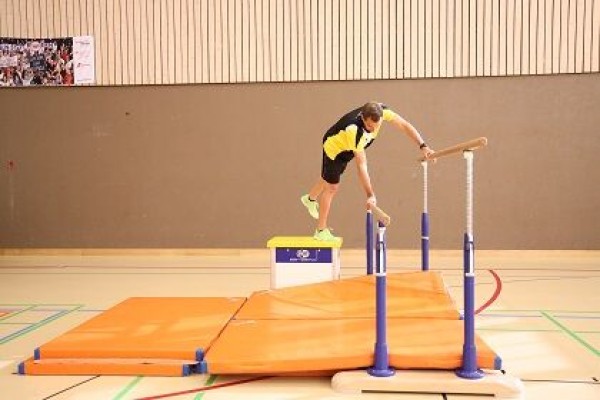
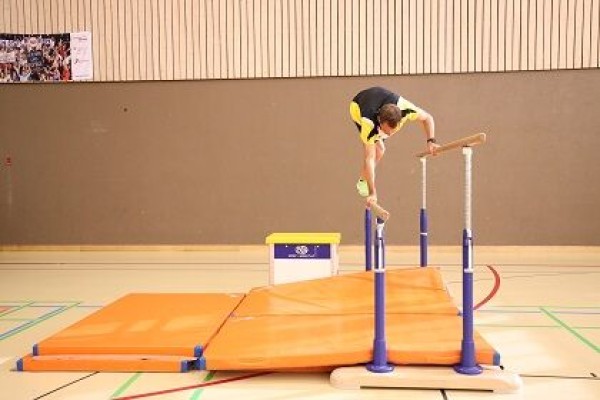

Climb onto the low bars of the uneven bars via the vaulting box, hold onto both bars with your hands, drop your legs between the two bars into the support, swing your legs forwards and jump off the uneven bars over the low bars, landing with both legs on a soft mat next to the uneven bars.
1 bar
1 vaulting box
4-5 soft mats (small)
Post setup:
Fix the uprights of a bar at different heights (height difference approx. 30-50cm), place a vaulting box in front of the bar (3-4 elements), lay out soft mats underneath
.
Twister II
Parkour
Individual work
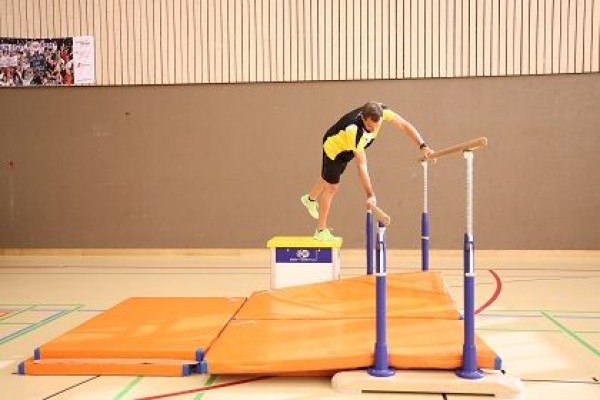
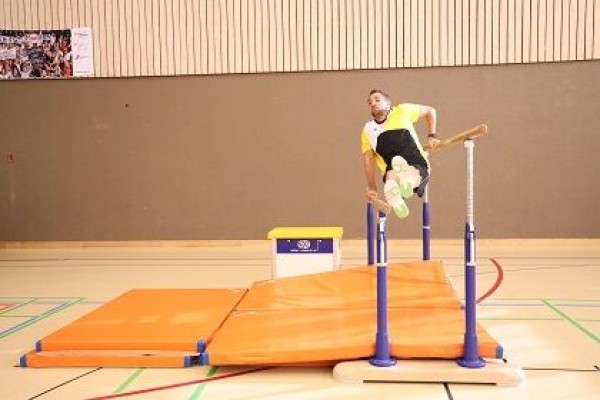

Stand on the vaulting box, hold on to both bars with your hands, jump with both legs into the support between the two bars, swing your legs forwards and jump off the uneven bars over the low bars, landing with both legs on a soft mat next to the uneven bars.
1 bar
1 vaulting box
4-5 soft mats (small)
Post setup:
Fix the uprights of a bar at different heights (height difference approx. 30-50cm), place a vaulting box in front of the bar (3-4 elements), lay out soft mats underneath
.
Twister III
Parkour
Individual work

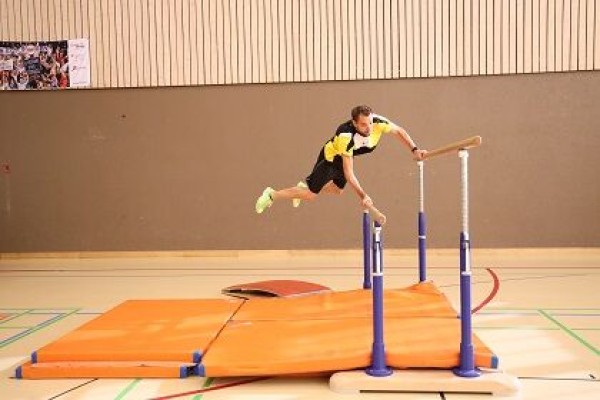

Short run-up, two-legged jump from the Reuter board into the support between the two bars of the uneven bars, swing the legs forwards and jump off the uneven bars over the low bars, landing with both legs on a soft mat next to the uneven bars.
1 bar
1 Reuter board
4-5 soft mats (small)
Post setup:
Fix the uprights of a bar at different heights (height difference approx. 30-50cm), place a Reuter board in front of the bar, lay out soft mats underneath
Twister IV
Parkour
Individual work
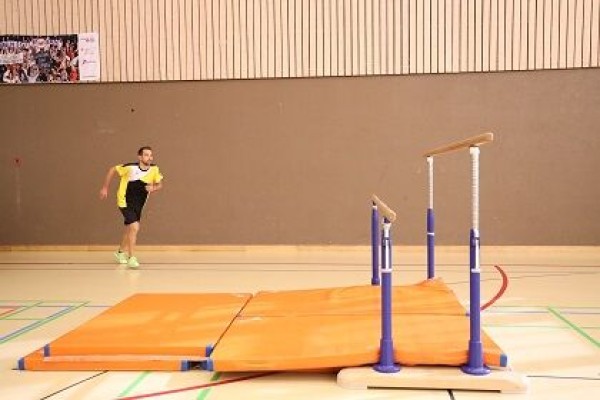
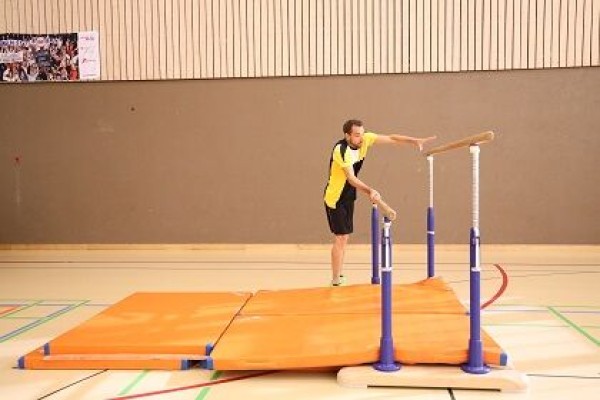
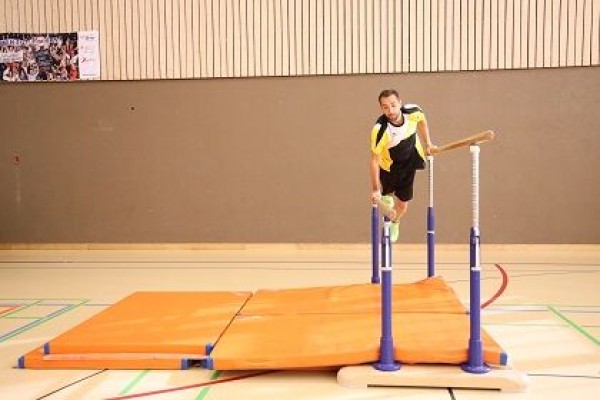
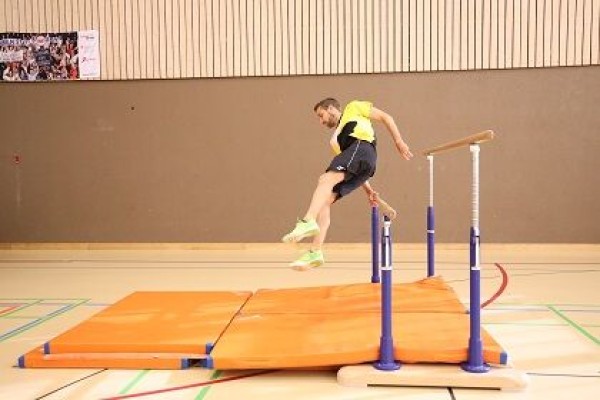
Short run-up, two-legged jump into the support between the two bars of the uneven bars, swing legs forwards and jump off the uneven bars over the low bars, two-legged landing next to the bars.
1 bar
Post set-up:
Fix the uprights of the bar at different heights (height difference approx. 30-50cm).
Skip
Power
Individual work

Round race with (3) obstacles (e.g. hurdles or a rope stretched between two stakes). The aim is to jump over the obstacles.
Attention:
Suspend the landing with your legs (lower your buttocks).
Lighten:
Lower obstacles.
Harden:
Higher obstacles.
Variant:
Jump up again immediately after landing (explosive power) or take a roughly right angle with your knees when landing and hold this position briefly before jumping off again.
2 stakes/1 rope or 1 hurdle = 1 obstacle
Alternating skipping and crawling under
Power
Individual work


Round course with (2) obstacles (e.g. hurdles or a rope stretched between two stakes). The aim is to alternately jump over and crawl under the obstacle once.
Attention:
Suspend the landing.
Lighten:
Lower speed; lower obstacle for jumping over; higher obstacle for crawling under.
Harden:
Higher speed; higher obstacle for jumping over; lower obstacle for crawling under.
2 stakes/1 rope or 1 hurdle = 1 obstacle
2 marking cones/caps
Alternating skipping and crawling under
Power
Individual work


Round course with various obstacles: The horse/swinging box is jumped over, at the single swinging box element you crawl/crawl through the opening.
Lighten:
Lower speed; lower elements to jump over/higher elements to crawl under.
Harden:
Higher speed; higher elements to jump over/lower elements to crawl under.
1-2 pommel horses
1-2 vaulting boxes
or instead of pommel horses and vaulting boxes, skipping ropes can be stretched between two painting sticks at different heights for jumping over/crawling under
4-8 painting sticks
2-4 ropes
3-6 soft mats (small)
2 painting sticks (optionally as a reversible pole)
Overcoming an obstacle
Power
Individual work
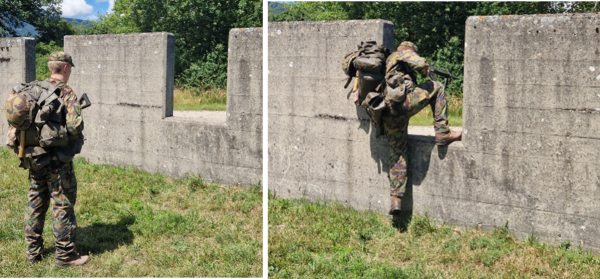
Overcoming a wall or opening using house and location fighting techniques (regulation 53.008.01 - chapter 6.3).
Lighten:
Without equipment;
Less high wall;
Without opening.
Harden:
With a protective waistcoat;
Higher wall.
Material per participant: Tenue CNK 420
Additional material: small wall/ruins, 1 protective vest
Overcoming an obstacle I (ventral franchissement)
Parkour
Individual work

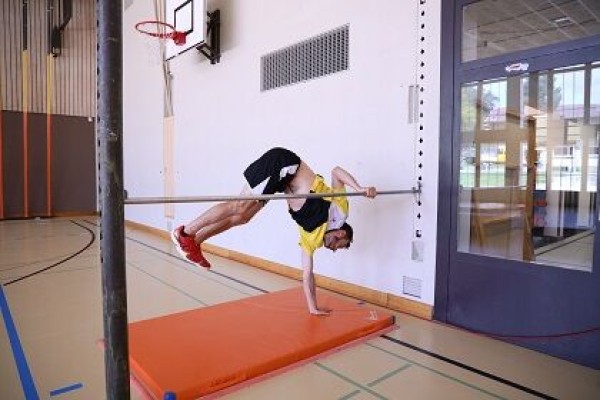
Stand frontally to the (horizontal) bar, hips leaning against the (horizontal) bar, bend the upper body over the bar and support one arm on the opposite side on the soft mat/floor, hold on to the (horizontal) bar with the other hand next to the hip in an underhand grip, now swing the legs vertically over the horizontal bar in an arching movement to land on the feet.
1 (horizontal) bar
1 soft mat (small) ► Indoor version
Indoor post setup:
Fix a horizontal bar at hip height and place a soft mat underneath.
Outdoor:
A bar or similar at approx. hip height.
Overcoming an obstacle II (abdominal turn)
Parkour
Individual work
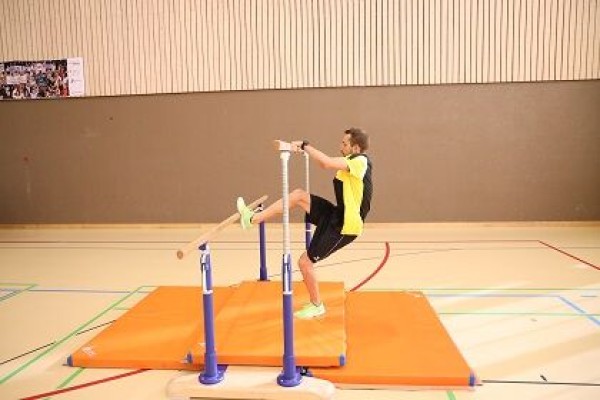

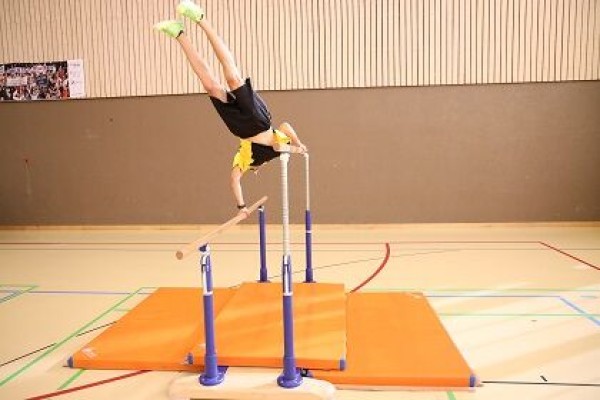
Support with both arms on the high bar, one hand grips the low bar (lean upper body forwards), the other hand still holds on to the upper bar next to the hips, now swing the legs vertically over the upper bar in an arching movement, landing in a standing position next to the bar on a soft mat.
1 parallel bars
4 soft mats (small)
Post setup:
Adjust the height of the parallel bars so that there is a height difference of approx. 50 cm. Lay out several soft mats under the parallel bars.
Overcoming an obstacle III (abdominal turn)
Parkour
Individual work

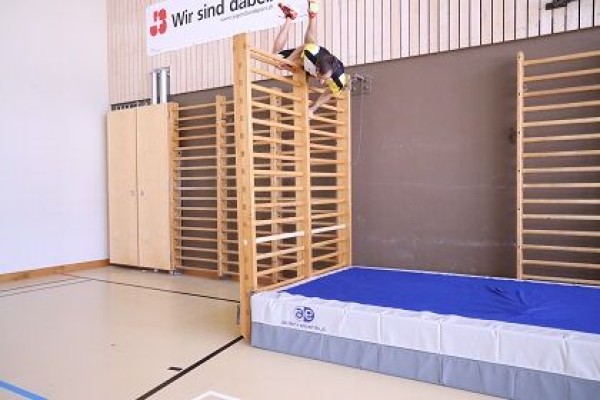

Stand on the wall bars, support yourself with both arms on the top rung with an underhand grip, and press your hips against that rung, bend your upper body over the wall bars and grab a rung as low as possible with one hand, now swing your legs vertically over the wall bars in an arching movement, landing in a standing position on the soft mat.
1 wall bars
1 soft mat (large)
Post assembly:
Loosen the wall bars and attach them at a 90 degree angle to the wall, place a large soft mat behind them.
Outnumbered: 3 against 1
Forms of play / exercises
Group work
Groups of 4 ► 3 vs. 1
Three players (A, B and C) pass the ball/throwing disc to each other in a confined space. A fourth player (D) tries to intercept the ball/disc. If player D is able to catch the ball/disc, he swaps places with the player who made the mistake. If an attacking player makes a mistake (e.g. leaving the boundary of the court with the ball/disc, inaccurate pass so that the ball/disc leaves the court), they must also assume the role of defender.
Variant:
Players B and C must always pass to player A.
Participant:
1 bat/stick ►intercross/lacrosse, smolball, floorball
Pitch:
1 ball/throwing disc ►basketball, Frisbee Ultimate, FooBaSKILL, futsal/football, handball, intercross/lacrosse, smolball, tchoukball, floorball
4 marking cones/caps (optional) ►pitch boundary
Outnumbered: 5 against 2
Forms of play / exercises
Group work
Groups of 7 ► 5 vs. 2
Depending on the number of participants, the overcount situation can be adjusted.
Exercise description:
5 attackers play against 2 defenders. The aim of the exercise is to encourage free running, accurate passing and anticipation. The attackers try to pass to each other (e.g. 15 passes = 1 point). The defenders aim to touch an attacker who is in possession of the ball/disc. If they succeed, the counting of successful passes starts again. After a few attempts, the team composition/roles are changed.
Participant:
1 stick/stick ►Inercross/Lacrosse, Smolball, Floorball
Pitch:
1 ball/throwing disc ►Basketball, Blitzball/Touchrugby, Frisbee Ultimate, FooBaSKILL, Futsal/Football, Handball, Intercross/Lacrosse, Smolball, Tchoukball, Floorball
2 playing ribbons (optional) ► Defence player marking
4 marking cones/caps (optional) ► Playing field boundary
Outnumbered: 5 against 2
Forms of play / exercises
Group work
Groups of 7 ► 5 vs. 2
Depending on the number of participants, the overcount situation can be adjusted.
Exercise description:
Five players (A, B, C, D and E) pass the ball/throwing disc to each other in a confined space. Two other players (F and G) try to intercept the ball/disc. If a defending player (F/G) is able to catch the ball/disc, he/she swaps places with the player who made the mistake. If an attacking player makes a mistake (e.g. leaving the boundary of the court with the ball/disc, inaccurate pass so that the ball/disc leaves the court), the roles are also swapped and the defender who has held the position longer may swap roles with the attacker.
Variant:
Back passes to the player from whom the pass was received are not permitted.
Participant:
1 bat/stick ►intercross/lacrosse, smolball, floorball
Pitch:
1 ball/throwing disc ►basketball, Frisbee Ultimate, FooBaSKILL, futsal/football, handball, intercross/lacrosse, smolball, tchoukball, floorball
4 marking cones/caps (optional) ►pitch boundary
Outnumbered: 7 against 4
Forms of play / exercises
Group work
Groups of 11 ►7 vs. 4
Depending on the number of participants, the overcount situation can be adjusted.
Exercise description:
There are 7 attackers playing against 4 defenders. The aim of the exercise is to promote free running, accurate passing and anticipation. The attackers try to pass to each other (e.g. 15 passes = 1 point). The defenders aim to touch an attacker who is in possession of the ball/disc. If they succeed, the counting of successful passes starts again. After a few attempts, the team composition/roles are changed.
Participant:
1 stick/stick ►intercross/lacrosse, smolball, floorball
Pitch:
1 ball/throwing disc ►Basketball, Blitzball/Touchrugby, Frisbee Ultimate, FooBaSKILL, Futsal/Football, Handball, Intercross/Lacrosse, Smolball, Tchoukball, Floorball
4 playing ribbons/sticks ►Defence player marking
4 marking cones/caps (optional) ►Field boundary
Conversion
Miscellaneous
All participants help to set up the workplace (the hall or the grounds) together.
Note: If not all participants are needed for the conversion, the participants who are not deployed can use the time for a (drinking) break.
Unihockey
Games / Tournament
Game idea:
Two teams with several outfield players and a goalkeeper play the ball into the opponent's goal through skilful attacking. Good defensive behaviour should prevent the opponent from scoring goals.
Scoring:
A goal is scored when the ball completely crosses the opponent's goal line.
Playing field:
Unihockey field (14mx21m) separated by boards. Two goals with a goal area (4.5mx3.5m).
Number of participants:
4 against 4 (3 field players plus goalkeeper)
Game rules:
The game begins in each section and after each goal with a face-off in the centre of the field by means of a bully.
The ball may only be played with the stick (except when the ball is advanced with the foot). The goalkeeper plays without a stick and may use his hands to defend or play the ball.
It is forbidden to lunge or swing the stick above hip height. You may not hit the opponent's stick or body with your own stick. Lifting the opponent's stick is also not permitted. A player may not lie down on the ground (maximum 3-point contact). When receiving the ball, at least one foot must touch the ground.
If the ball leaves the playing area, it is brought back into play by the opposing team within the playing area by means of a free hit (exception behind the goal: in this case, the face-off takes place at the next face-off spot from the corner of the playing area). Even after a foul, the free hit is taken at the place of the offence, unless it happened behind the baseline. The opposing players must keep a distance of two metres from each free hit.
Unihockey: Assist-Spiel
Forms of play / exercises
2 teams of 3-4 players each

Two teams of 3-4 players play against each other. A goal scored only counts if all players have touched the ball in succession. The same player may not score two goals in succession.
Objective: Good free running, accurate passing.
Per pitch:
2 floorball goals
1 floorball
Pro Tn:
1 floorball stick
Floorball: supplying balls
Forms of play / exercises
2 Teams

2 teams play against each other. One group has its goals (raised boxes) in the corners of the pitch, the other in the centre of the hall (1-2 mats). The aim is to put as many balls as possible into the goals or onto the mat for the opposing team. Only one ball is allowed per run. Which team will have fewer balls in/on their goal after 2 minutes
Objective: ball control during the run, looking away from the ball, developing a game strategy
Pitch:
1 vaulting box
2 soft mats (small)
Uni hockey balls
Participant:
1 floorball stick
Unihockey: Karussell
Forms of play / exercises
Group work
Simple standard pass and shot exercise: The players stand in both corners next to the goal. The foremost player runs in a high arc into the centre in front of the goal (around the marker stick). There he receives the ball from the other side and shoots (at the height of the two cones). The passer runs up next and shoots at the goal.
Variations:
Shooting at the empty goal or whoever has shot then stands in the goal themselves.
The sports leader can demand different types of shots (direct shots are also possible).
Per group:
1 Floorball goal
Hockey balls
4 hats (incl. starting markers)
1 colouring stick
Per Tn:
1 Floorball stick